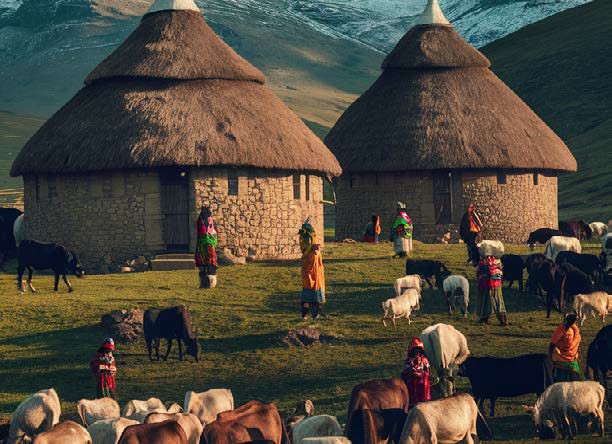The ‘Lost’ Fruits of Africa

Passionate about getting God's message concerning Afrika and the end…
Why did we abandon them?
*Based on the Lost Crops of Africa
Technically speaking, a tree that does not produce fruit should be called barren and a fruit that does not have seeds should be called dead because it cannot reproduce itself. It’s pretty straightforward.
Of what use is a fruit tree if it does not have fruits, and of what use is a fruit if it does not have seeds to recreate itself? No use. But this is the reality we face globally, and more people are embracing the foolishness. How can you be happy to eat a seedless grape, a seedless orange or a seedless mango simply because someone has made its juice sweeter or its colour brighter? Or how can you not be worried when some globalist-owned corporations are making fruits and other crops seedless so that you can buy and continue to buy their dead-on-arrival GMO seeds?
How does that even make sense?
We are pretty sure that some people will have a different opinion about this and that’s ok. But to not talk about the foolishness of modern-day farming that loves to undermine natural processes for gain, is nothing but another form of slavery.
We will be talking about two categories of “lost” African fruits, “The Cultivated Fruits” and “The Wild Fruits”. In this article, we will talk about cultivated fruits.
Cultivated Fruits
1. Balanites (desert date, lalob)
This small tree (Balanites aegyptiaca, Balanitaceae) tolerates heat and aridity so well it thrives in the heart of the Sahara. Deep-rooted and very spiny, it produces heavy yields of date-like fruits whose gummy, yellow-tored pulp is more than a third sugar. Although these sweet treats are eaten raw, they are more commonly used as ingredients in cooked dishes. Some, however, are crushed and converted into drinks. The fruit also yields a kernel roughly matching sesame and soybean in composition, being about half oil and a third protein. To become edible it must be boiled for some time, but then it can be turned into many tasty items, including roasted snacks and a spread not unlike peanut butter. Imagine I have this very tree in my compound but had no clue what it was until we did this video. And that goes to show you how much we must take time to know, appreciate and use the resources within our environments.
2. Baobab
Few trees on earth engender respect like the baobab (Adansonia digitata, Bombacaceae). Millions believe it receives divine power through the branches that look like arms stretching skyward (see the chapter on baobab as a vegetable in Volume II). Its fruits sometimes attain the size of melons, and their tough outer casings enclose angular packets of a strange, sticky pulp. A few hours in the sun dries this semisolid into a free-flowing, soluble powder. The resulting “baobab fruit flour” has a gingerbread flavour enlivened by a not unpleasant acid bite. It is nutritious enough to be stirred into warm water or milk to create a healthy drink. The fruit also contains nuts with an almond-like taste. Although difficult to get at (owing to a thick shell) the nuts are valued foodstuffs, eaten fresh, fermented, or roasted like peanuts. They are rich in both food energy and quality protein.
3. Butterfruit (safou, bush mango)
Butterfruit (Dacryodes edulis, Burseraceae) may be unknown to the world, but in Central Africa and neighbouring sections of West Africa, this small tree is an almost universal component of traditional farming.
Throughout this broad tropical belt, it contributes importantly to nutrition and farmer income. Like tomato or eggplant, the fruit is mainly used as a vegetable. It has a pleasant smell and attractive appearance and is extremely high in food energy. Indeed, up to two-thirds of the pulp comprises an oil of very desirable composition. In addition, the pulp is one of the best protein sources to be found in the world of fruits. About a quarter of the dry pulp is protein, and it is of superior nutritional quality. To top all that, butterfruit provides notable dietary minerals.
4. Carissa
Carissa (Carissa macrocarpa, Apocynaceae), from South Africa and Mozambique, yields masses of shiny fruits that are often called Natal plums. Their thin red skin covers a pinkish-red, almost mealy, flesh that is flecked with a milky juice.
Flavour varies from tart to more or less sweet, depending upon variety and maturity. Even though production is now haphazard and essentially unsupported by the muscle of modern knowledge, carissa promises to become a much greater crop. Even in its present form, this fruit has an ample edible portion and, having no stone in the centre, it can be eaten whole. These versatile foodstuffs make tasty jams, jellies, and drinks as well as attractive highlights in salads and desserts of all kinds. Some taste like raspberry; most, though, are as tart as cranberry.
5. Horned Melon
A spiky orange oddity crammed with green jelly and white seeds, the horned melon (Cucumis metulifer, Cucurbitaceae) has gone global in recent decades; New Zealand, Israel, and Kenya are among countries shipping it around the world. Back in its native habitat, southern Africa, the plant is little used, but in a few places—Malawi, for instance—people grow it for sale in the local food markets. Seemingly, its home territories could make much more of this strange comestible, not only as a dessert fruit but also as a vegetable like cucumber.
6. Kei Apple
The shrubby plant known botanically as Dovyalis caffra (Flacourtiaceae) produces fruits that resemble little golden apples. Indigenous to the southern zone—including Malawi, Zimbabwe, Mozambique, and South Africa—it becomes bespangled with fruits whose thin, tough skin shelters a yellow, melting, juicy pulp with a lively aroma.
7. Marula
Marula (Sclerocarya birrea, Anacardiaceae) is prized for its fruits as well as its seeds. Both are in high demand from Cape Verde to the Cape of Good Hope. In some societies, the tree ranks as a major food supplier. The plum-sized fruits have a thick yellow peel and translucent white flesh. They can be eaten fresh but most are processed into things such as beverages, jams, and jellies. Although the succulent pulp has a unique flavour, writers struggling for a frame of reference have variously likened it to litchi, apple, guava, or pineapple. The kernels inside the seeds are commonly compared to macadamia nuts.
8. Melon
The melon (canteloupe, muskmelon; Cucumis melo, Cucurbitaceae) is one of the two African fruits that are known around the world. All the warmer regions produce it, of course, and millions enjoy a melon for breakfast, lunch, or dessert. Today’s melons are based almost entirely on seeds carried out of Africa, probably on the backs of camels northward across the Sahara in the time of the Pharaohs. While today India, Japan, and many other countries have greatly improved, locally selected varieties, the full wealth of the species’ diversity was not only left behind, it was forgotten, and remains to this day largely untapped. Who knows what kinds of 21st-century melons can be developed by finally utilizing the “lost” half of this fruit’s heritage?
9. Tamarind
Throughout the tropics tamarind (Tamarindus indica, Leguminosae) provides an attractive backdrop to roadsides, fields, and markets from the East Indies to the West Indies. And everywhere it grows, people enjoy the shade cast by its feathery foliage, not to mention the curiously sweet-sour pulp found inside its brittle, grey-brown pods. What is not widely known is that tamarind is actually from western Africa. The original wild version, a common savanna tree, can be found over an area stretching from the Atlantic seaboard to the verge of Central Africa’s rainforests and east. Senegal’s capital is named for this tree, which in the local Wolof language is called “Dakar.” Despite its current spread, this species is far from fully exploited, and it could become an even greater tree in the tropics, notably including countries within the boundaries of its home continent.
10. Watermelon
Other than botanists, few people consider that watermelon (Citrullus lanatus, Cucurbitaceae) is indeed African. Yet this crop’s wild ancestors are scattered abundantly across the dry wastes of the continent’s semi-arid southern hinterland. The ancestral genes to be found in the wild and tended watermelons bespeckling millions of hectares in countries such as Botswana and Namibia seem likely to provide the genetic means for creating new varieties, new seed foods, new pickles, and new types of watermelon fruits with unusual colors, shapes, sizes, and flavors. It is entirely possible that genes from Africa’s wild types could soon spark a watermelon rebirth worldwide.
Now, concerning the thought around the lost fruits of Africa, the only reason why these fruits are considered ‘lost’ is because Africans have lost their connection to the beauty, nutrition and ability of these fruits to save the continent from the so-called food insecurity. We have embraced foreign fruits and abandoned the very indigenous African fruits that were tailored to our nutritional needs.
To show you how much we have lost connection with our indigenous fruits, ask yourself, when was the last time Tamarind came to your mind when you were planning to go shopping?
That’s how deep our disconnection from our African crops is. But we can make changes. We can start now.
What's Your Reaction?
Passionate about getting God's message concerning Afrika and the end times to the world, in order to heal, restore and rebirth Afrika to her true purpose and destiny in God.

















